Technology in transport Industry Assignment pdf
VerifiedAdded on 2021/06/17
|8
|1819
|64
AI Summary
Contribute Materials
Your contribution can guide someone’s learning journey. Share your
documents today.

Running Head: THE SOCIETY IS READY FOR DRIVERLESS CARS 1
The Society Is Ready For Driverless Cars
Students Name
Institution
Course instructor
Date
The Society Is Ready For Driverless Cars
Students Name
Institution
Course instructor
Date
Secure Best Marks with AI Grader
Need help grading? Try our AI Grader for instant feedback on your assignments.
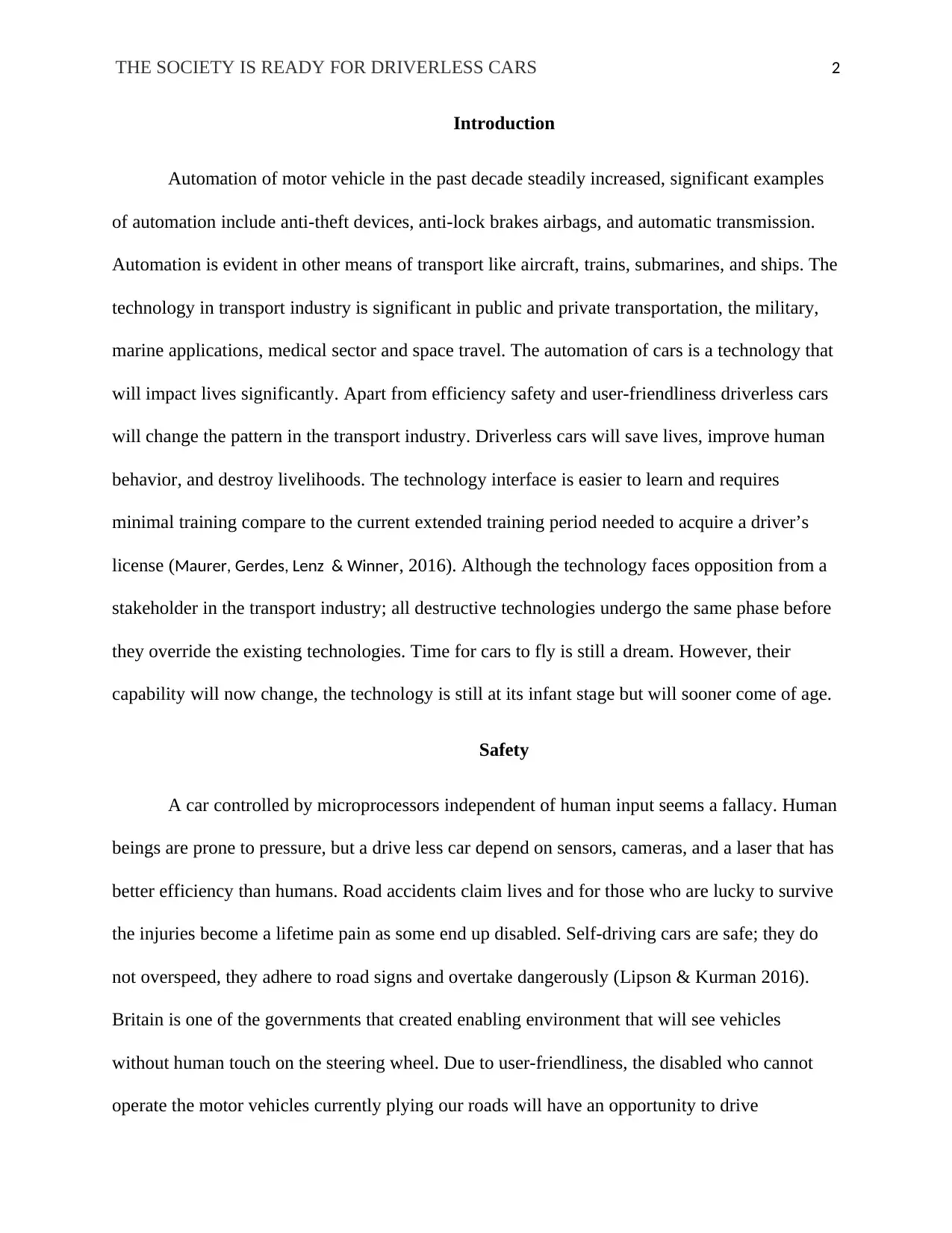
THE SOCIETY IS READY FOR DRIVERLESS CARS 2
Introduction
Automation of motor vehicle in the past decade steadily increased, significant examples
of automation include anti-theft devices, anti-lock brakes airbags, and automatic transmission.
Automation is evident in other means of transport like aircraft, trains, submarines, and ships. The
technology in transport industry is significant in public and private transportation, the military,
marine applications, medical sector and space travel. The automation of cars is a technology that
will impact lives significantly. Apart from efficiency safety and user-friendliness driverless cars
will change the pattern in the transport industry. Driverless cars will save lives, improve human
behavior, and destroy livelihoods. The technology interface is easier to learn and requires
minimal training compare to the current extended training period needed to acquire a driver’s
license (Maurer, Gerdes, Lenz & Winner, 2016). Although the technology faces opposition from a
stakeholder in the transport industry; all destructive technologies undergo the same phase before
they override the existing technologies. Time for cars to fly is still a dream. However, their
capability will now change, the technology is still at its infant stage but will sooner come of age.
Safety
A car controlled by microprocessors independent of human input seems a fallacy. Human
beings are prone to pressure, but a drive less car depend on sensors, cameras, and a laser that has
better efficiency than humans. Road accidents claim lives and for those who are lucky to survive
the injuries become a lifetime pain as some end up disabled. Self-driving cars are safe; they do
not overspeed, they adhere to road signs and overtake dangerously (Lipson & Kurman 2016).
Britain is one of the governments that created enabling environment that will see vehicles
without human touch on the steering wheel. Due to user-friendliness, the disabled who cannot
operate the motor vehicles currently plying our roads will have an opportunity to drive
Introduction
Automation of motor vehicle in the past decade steadily increased, significant examples
of automation include anti-theft devices, anti-lock brakes airbags, and automatic transmission.
Automation is evident in other means of transport like aircraft, trains, submarines, and ships. The
technology in transport industry is significant in public and private transportation, the military,
marine applications, medical sector and space travel. The automation of cars is a technology that
will impact lives significantly. Apart from efficiency safety and user-friendliness driverless cars
will change the pattern in the transport industry. Driverless cars will save lives, improve human
behavior, and destroy livelihoods. The technology interface is easier to learn and requires
minimal training compare to the current extended training period needed to acquire a driver’s
license (Maurer, Gerdes, Lenz & Winner, 2016). Although the technology faces opposition from a
stakeholder in the transport industry; all destructive technologies undergo the same phase before
they override the existing technologies. Time for cars to fly is still a dream. However, their
capability will now change, the technology is still at its infant stage but will sooner come of age.
Safety
A car controlled by microprocessors independent of human input seems a fallacy. Human
beings are prone to pressure, but a drive less car depend on sensors, cameras, and a laser that has
better efficiency than humans. Road accidents claim lives and for those who are lucky to survive
the injuries become a lifetime pain as some end up disabled. Self-driving cars are safe; they do
not overspeed, they adhere to road signs and overtake dangerously (Lipson & Kurman 2016).
Britain is one of the governments that created enabling environment that will see vehicles
without human touch on the steering wheel. Due to user-friendliness, the disabled who cannot
operate the motor vehicles currently plying our roads will have an opportunity to drive
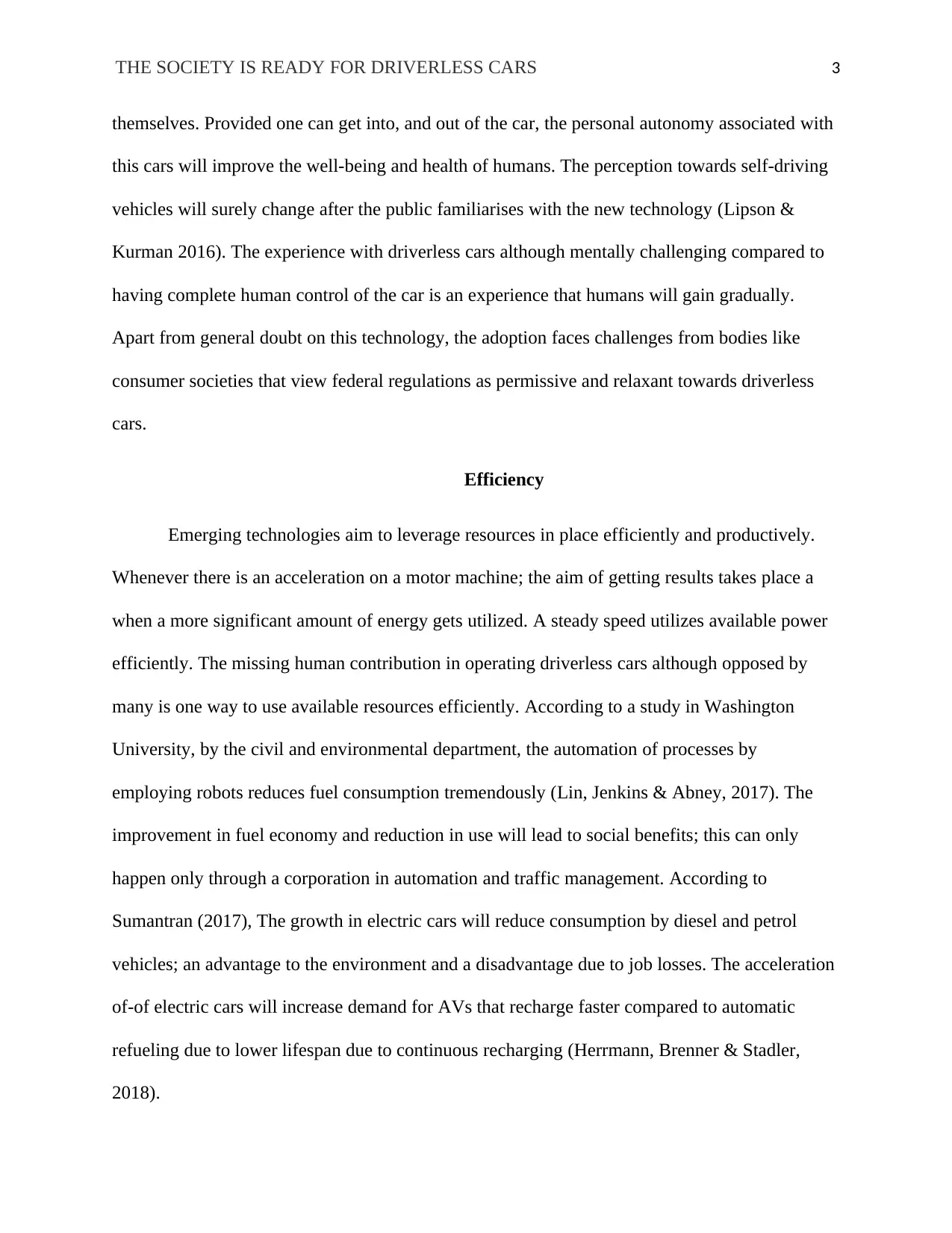
THE SOCIETY IS READY FOR DRIVERLESS CARS 3
themselves. Provided one can get into, and out of the car, the personal autonomy associated with
this cars will improve the well-being and health of humans. The perception towards self-driving
vehicles will surely change after the public familiarises with the new technology (Lipson &
Kurman 2016). The experience with driverless cars although mentally challenging compared to
having complete human control of the car is an experience that humans will gain gradually.
Apart from general doubt on this technology, the adoption faces challenges from bodies like
consumer societies that view federal regulations as permissive and relaxant towards driverless
cars.
Efficiency
Emerging technologies aim to leverage resources in place efficiently and productively.
Whenever there is an acceleration on a motor machine; the aim of getting results takes place a
when a more significant amount of energy gets utilized. A steady speed utilizes available power
efficiently. The missing human contribution in operating driverless cars although opposed by
many is one way to use available resources efficiently. According to a study in Washington
University, by the civil and environmental department, the automation of processes by
employing robots reduces fuel consumption tremendously (Lin, Jenkins & Abney, 2017). The
improvement in fuel economy and reduction in use will lead to social benefits; this can only
happen only through a corporation in automation and traffic management. According to
Sumantran (2017), The growth in electric cars will reduce consumption by diesel and petrol
vehicles; an advantage to the environment and a disadvantage due to job losses. The acceleration
of-of electric cars will increase demand for AVs that recharge faster compared to automatic
refueling due to lower lifespan due to continuous recharging (Herrmann, Brenner & Stadler,
2018).
themselves. Provided one can get into, and out of the car, the personal autonomy associated with
this cars will improve the well-being and health of humans. The perception towards self-driving
vehicles will surely change after the public familiarises with the new technology (Lipson &
Kurman 2016). The experience with driverless cars although mentally challenging compared to
having complete human control of the car is an experience that humans will gain gradually.
Apart from general doubt on this technology, the adoption faces challenges from bodies like
consumer societies that view federal regulations as permissive and relaxant towards driverless
cars.
Efficiency
Emerging technologies aim to leverage resources in place efficiently and productively.
Whenever there is an acceleration on a motor machine; the aim of getting results takes place a
when a more significant amount of energy gets utilized. A steady speed utilizes available power
efficiently. The missing human contribution in operating driverless cars although opposed by
many is one way to use available resources efficiently. According to a study in Washington
University, by the civil and environmental department, the automation of processes by
employing robots reduces fuel consumption tremendously (Lin, Jenkins & Abney, 2017). The
improvement in fuel economy and reduction in use will lead to social benefits; this can only
happen only through a corporation in automation and traffic management. According to
Sumantran (2017), The growth in electric cars will reduce consumption by diesel and petrol
vehicles; an advantage to the environment and a disadvantage due to job losses. The acceleration
of-of electric cars will increase demand for AVs that recharge faster compared to automatic
refueling due to lower lifespan due to continuous recharging (Herrmann, Brenner & Stadler,
2018).
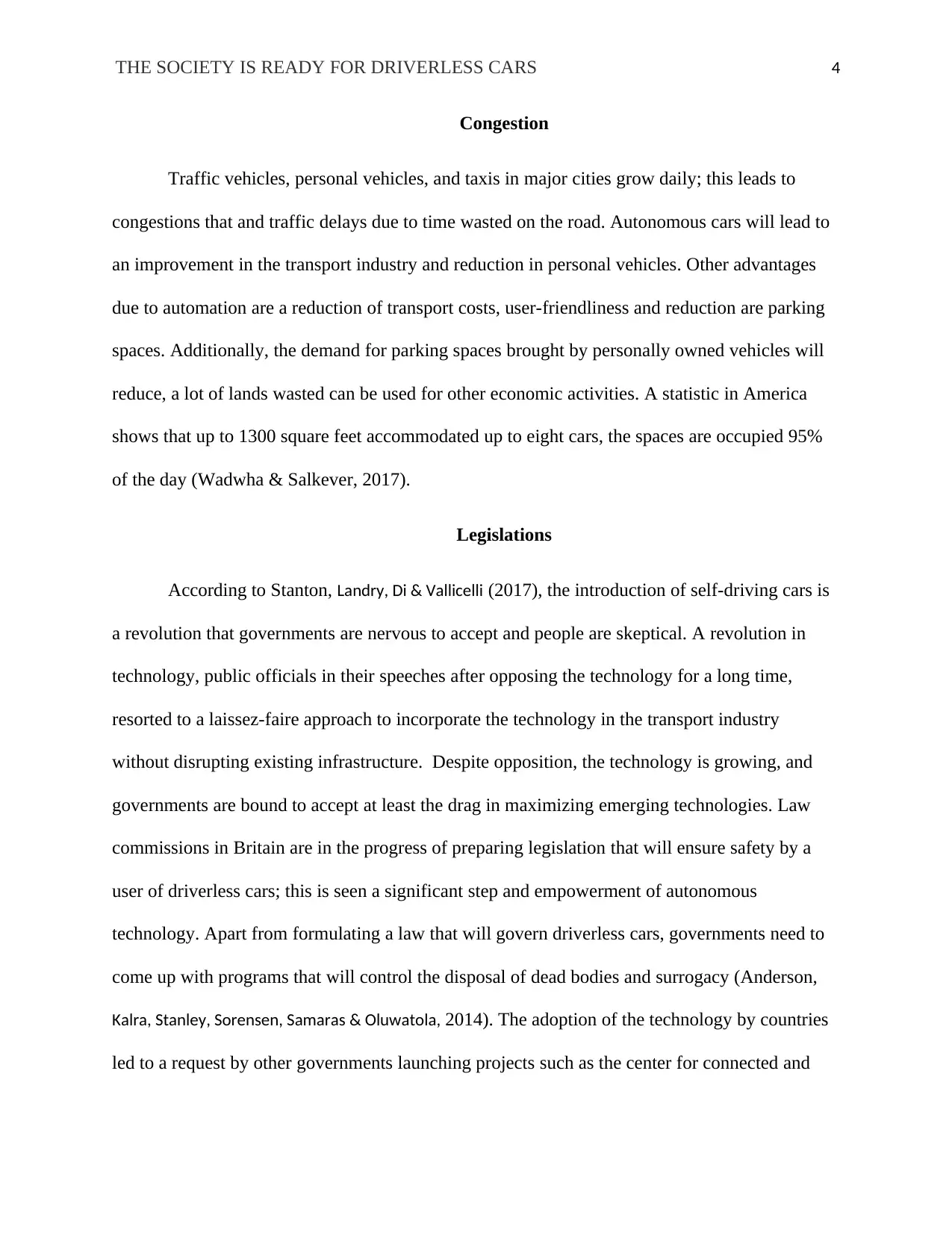
THE SOCIETY IS READY FOR DRIVERLESS CARS 4
Congestion
Traffic vehicles, personal vehicles, and taxis in major cities grow daily; this leads to
congestions that and traffic delays due to time wasted on the road. Autonomous cars will lead to
an improvement in the transport industry and reduction in personal vehicles. Other advantages
due to automation are a reduction of transport costs, user-friendliness and reduction are parking
spaces. Additionally, the demand for parking spaces brought by personally owned vehicles will
reduce, a lot of lands wasted can be used for other economic activities. A statistic in America
shows that up to 1300 square feet accommodated up to eight cars, the spaces are occupied 95%
of the day (Wadwha & Salkever, 2017).
Legislations
According to Stanton, Landry, Di & Vallicelli (2017), the introduction of self-driving cars is
a revolution that governments are nervous to accept and people are skeptical. A revolution in
technology, public officials in their speeches after opposing the technology for a long time,
resorted to a laissez-faire approach to incorporate the technology in the transport industry
without disrupting existing infrastructure. Despite opposition, the technology is growing, and
governments are bound to accept at least the drag in maximizing emerging technologies. Law
commissions in Britain are in the progress of preparing legislation that will ensure safety by a
user of driverless cars; this is seen a significant step and empowerment of autonomous
technology. Apart from formulating a law that will govern driverless cars, governments need to
come up with programs that will control the disposal of dead bodies and surrogacy (Anderson,
Kalra, Stanley, Sorensen, Samaras & Oluwatola, 2014). The adoption of the technology by countries
led to a request by other governments launching projects such as the center for connected and
Congestion
Traffic vehicles, personal vehicles, and taxis in major cities grow daily; this leads to
congestions that and traffic delays due to time wasted on the road. Autonomous cars will lead to
an improvement in the transport industry and reduction in personal vehicles. Other advantages
due to automation are a reduction of transport costs, user-friendliness and reduction are parking
spaces. Additionally, the demand for parking spaces brought by personally owned vehicles will
reduce, a lot of lands wasted can be used for other economic activities. A statistic in America
shows that up to 1300 square feet accommodated up to eight cars, the spaces are occupied 95%
of the day (Wadwha & Salkever, 2017).
Legislations
According to Stanton, Landry, Di & Vallicelli (2017), the introduction of self-driving cars is
a revolution that governments are nervous to accept and people are skeptical. A revolution in
technology, public officials in their speeches after opposing the technology for a long time,
resorted to a laissez-faire approach to incorporate the technology in the transport industry
without disrupting existing infrastructure. Despite opposition, the technology is growing, and
governments are bound to accept at least the drag in maximizing emerging technologies. Law
commissions in Britain are in the progress of preparing legislation that will ensure safety by a
user of driverless cars; this is seen a significant step and empowerment of autonomous
technology. Apart from formulating a law that will govern driverless cars, governments need to
come up with programs that will control the disposal of dead bodies and surrogacy (Anderson,
Kalra, Stanley, Sorensen, Samaras & Oluwatola, 2014). The adoption of the technology by countries
led to a request by other governments launching projects such as the center for connected and
Secure Best Marks with AI Grader
Need help grading? Try our AI Grader for instant feedback on your assignments.
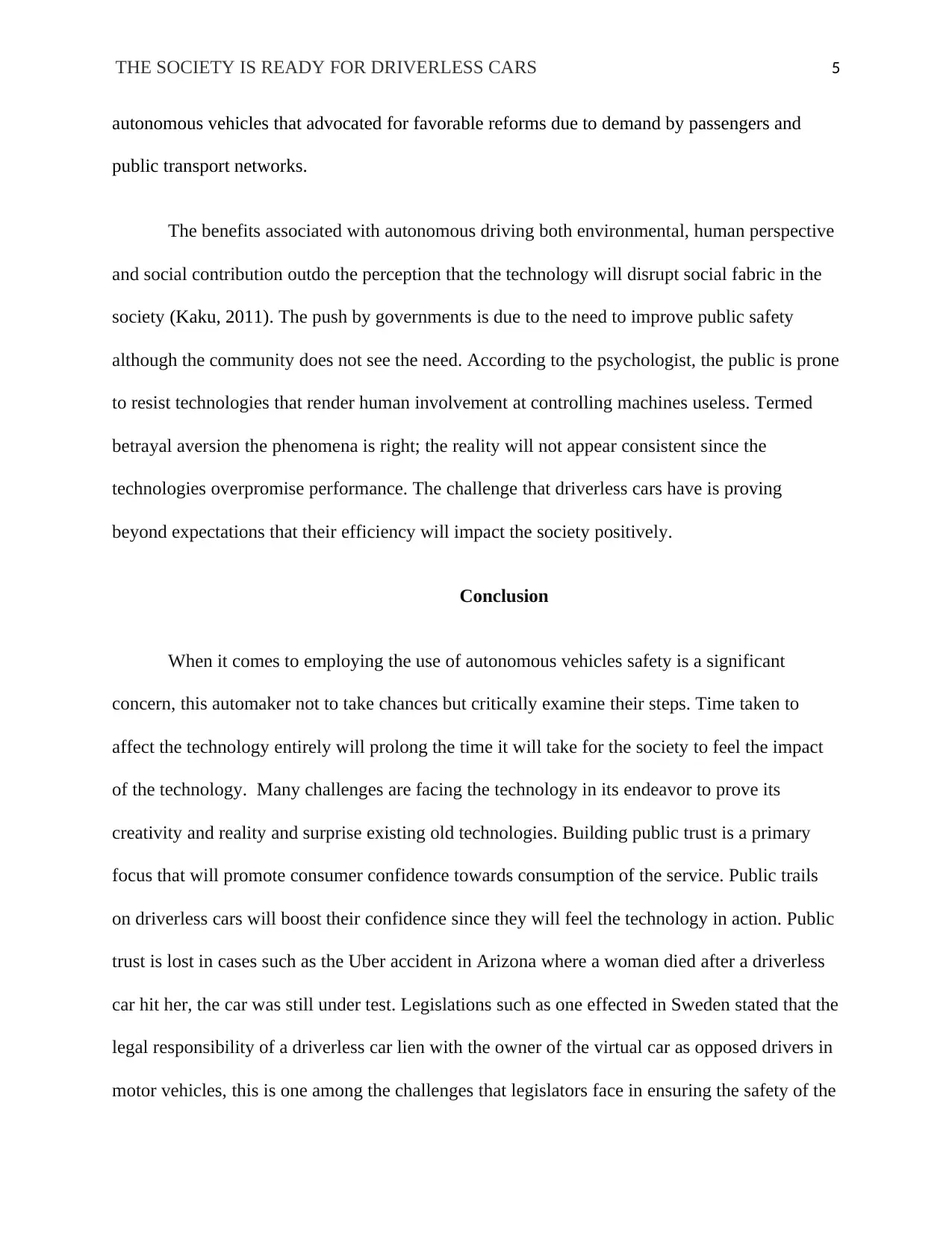
THE SOCIETY IS READY FOR DRIVERLESS CARS 5
autonomous vehicles that advocated for favorable reforms due to demand by passengers and
public transport networks.
The benefits associated with autonomous driving both environmental, human perspective
and social contribution outdo the perception that the technology will disrupt social fabric in the
society (Kaku, 2011). The push by governments is due to the need to improve public safety
although the community does not see the need. According to the psychologist, the public is prone
to resist technologies that render human involvement at controlling machines useless. Termed
betrayal aversion the phenomena is right; the reality will not appear consistent since the
technologies overpromise performance. The challenge that driverless cars have is proving
beyond expectations that their efficiency will impact the society positively.
Conclusion
When it comes to employing the use of autonomous vehicles safety is a significant
concern, this automaker not to take chances but critically examine their steps. Time taken to
affect the technology entirely will prolong the time it will take for the society to feel the impact
of the technology. Many challenges are facing the technology in its endeavor to prove its
creativity and reality and surprise existing old technologies. Building public trust is a primary
focus that will promote consumer confidence towards consumption of the service. Public trails
on driverless cars will boost their confidence since they will feel the technology in action. Public
trust is lost in cases such as the Uber accident in Arizona where a woman died after a driverless
car hit her, the car was still under test. Legislations such as one effected in Sweden stated that the
legal responsibility of a driverless car lien with the owner of the virtual car as opposed drivers in
motor vehicles, this is one among the challenges that legislators face in ensuring the safety of the
autonomous vehicles that advocated for favorable reforms due to demand by passengers and
public transport networks.
The benefits associated with autonomous driving both environmental, human perspective
and social contribution outdo the perception that the technology will disrupt social fabric in the
society (Kaku, 2011). The push by governments is due to the need to improve public safety
although the community does not see the need. According to the psychologist, the public is prone
to resist technologies that render human involvement at controlling machines useless. Termed
betrayal aversion the phenomena is right; the reality will not appear consistent since the
technologies overpromise performance. The challenge that driverless cars have is proving
beyond expectations that their efficiency will impact the society positively.
Conclusion
When it comes to employing the use of autonomous vehicles safety is a significant
concern, this automaker not to take chances but critically examine their steps. Time taken to
affect the technology entirely will prolong the time it will take for the society to feel the impact
of the technology. Many challenges are facing the technology in its endeavor to prove its
creativity and reality and surprise existing old technologies. Building public trust is a primary
focus that will promote consumer confidence towards consumption of the service. Public trails
on driverless cars will boost their confidence since they will feel the technology in action. Public
trust is lost in cases such as the Uber accident in Arizona where a woman died after a driverless
car hit her, the car was still under test. Legislations such as one effected in Sweden stated that the
legal responsibility of a driverless car lien with the owner of the virtual car as opposed drivers in
motor vehicles, this is one among the challenges that legislators face in ensuring the safety of the

THE SOCIETY IS READY FOR DRIVERLESS CARS 6
public. Software vulnerabilities and fault are a great concern to the industry also design interface
and assumptions on the accuracy of the driverless technology. In conclusion, it is high time the
transport sector adopt this new technology. Progressively the social implications will reduce,
political landscapes diverse environment and the transport industry will address the challenges
and adopt the technology. The society is ready to adopt the technology, what is needed is public
education and awareness campaigns that will prepare the public to embrace the revolutionary
technology.
public. Software vulnerabilities and fault are a great concern to the industry also design interface
and assumptions on the accuracy of the driverless technology. In conclusion, it is high time the
transport sector adopt this new technology. Progressively the social implications will reduce,
political landscapes diverse environment and the transport industry will address the challenges
and adopt the technology. The society is ready to adopt the technology, what is needed is public
education and awareness campaigns that will prepare the public to embrace the revolutionary
technology.
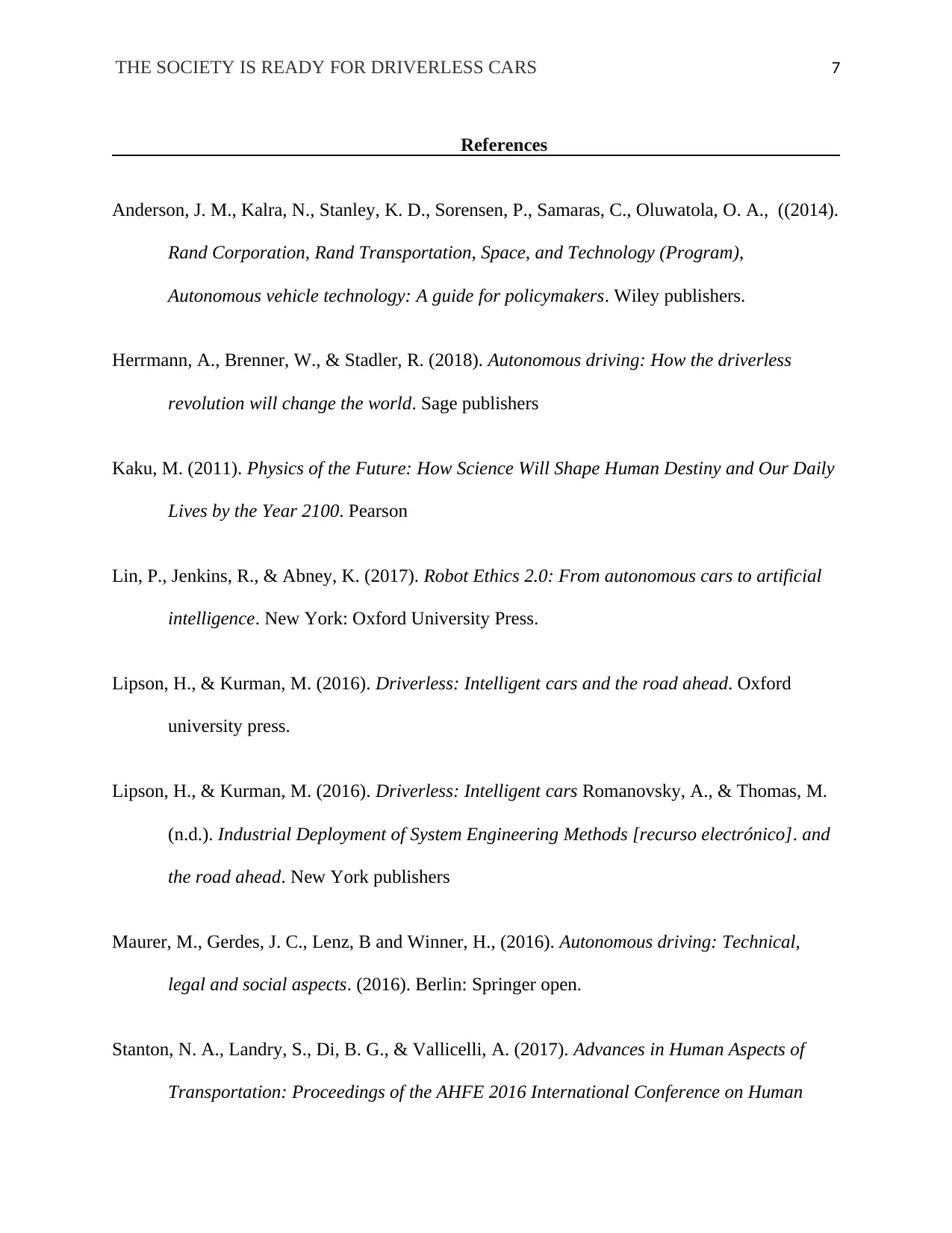
THE SOCIETY IS READY FOR DRIVERLESS CARS 7
References
Anderson, J. M., Kalra, N., Stanley, K. D., Sorensen, P., Samaras, C., Oluwatola, O. A., ((2014).
Rand Corporation, Rand Transportation, Space, and Technology (Program),
Autonomous vehicle technology: A guide for policymakers. Wiley publishers.
Herrmann, A., Brenner, W., & Stadler, R. (2018). Autonomous driving: How the driverless
revolution will change the world. Sage publishers
Kaku, M. (2011). Physics of the Future: How Science Will Shape Human Destiny and Our Daily
Lives by the Year 2100. Pearson
Lin, P., Jenkins, R., & Abney, K. (2017). Robot Ethics 2.0: From autonomous cars to artificial
intelligence. New York: Oxford University Press.
Lipson, H., & Kurman, M. (2016). Driverless: Intelligent cars and the road ahead. Oxford
university press.
Lipson, H., & Kurman, M. (2016). Driverless: Intelligent cars Romanovsky, A., & Thomas, M.
(n.d.). Industrial Deployment of System Engineering Methods [recurso electrónico]. and
the road ahead. New York publishers
Maurer, M., Gerdes, J. C., Lenz, B and Winner, H., (2016). Autonomous driving: Technical,
legal and social aspects. (2016). Berlin: Springer open.
Stanton, N. A., Landry, S., Di, B. G., & Vallicelli, A. (2017). Advances in Human Aspects of
Transportation: Proceedings of the AHFE 2016 International Conference on Human
References
Anderson, J. M., Kalra, N., Stanley, K. D., Sorensen, P., Samaras, C., Oluwatola, O. A., ((2014).
Rand Corporation, Rand Transportation, Space, and Technology (Program),
Autonomous vehicle technology: A guide for policymakers. Wiley publishers.
Herrmann, A., Brenner, W., & Stadler, R. (2018). Autonomous driving: How the driverless
revolution will change the world. Sage publishers
Kaku, M. (2011). Physics of the Future: How Science Will Shape Human Destiny and Our Daily
Lives by the Year 2100. Pearson
Lin, P., Jenkins, R., & Abney, K. (2017). Robot Ethics 2.0: From autonomous cars to artificial
intelligence. New York: Oxford University Press.
Lipson, H., & Kurman, M. (2016). Driverless: Intelligent cars and the road ahead. Oxford
university press.
Lipson, H., & Kurman, M. (2016). Driverless: Intelligent cars Romanovsky, A., & Thomas, M.
(n.d.). Industrial Deployment of System Engineering Methods [recurso electrónico]. and
the road ahead. New York publishers
Maurer, M., Gerdes, J. C., Lenz, B and Winner, H., (2016). Autonomous driving: Technical,
legal and social aspects. (2016). Berlin: Springer open.
Stanton, N. A., Landry, S., Di, B. G., & Vallicelli, A. (2017). Advances in Human Aspects of
Transportation: Proceedings of the AHFE 2016 International Conference on Human
Paraphrase This Document
Need a fresh take? Get an instant paraphrase of this document with our AI Paraphraser
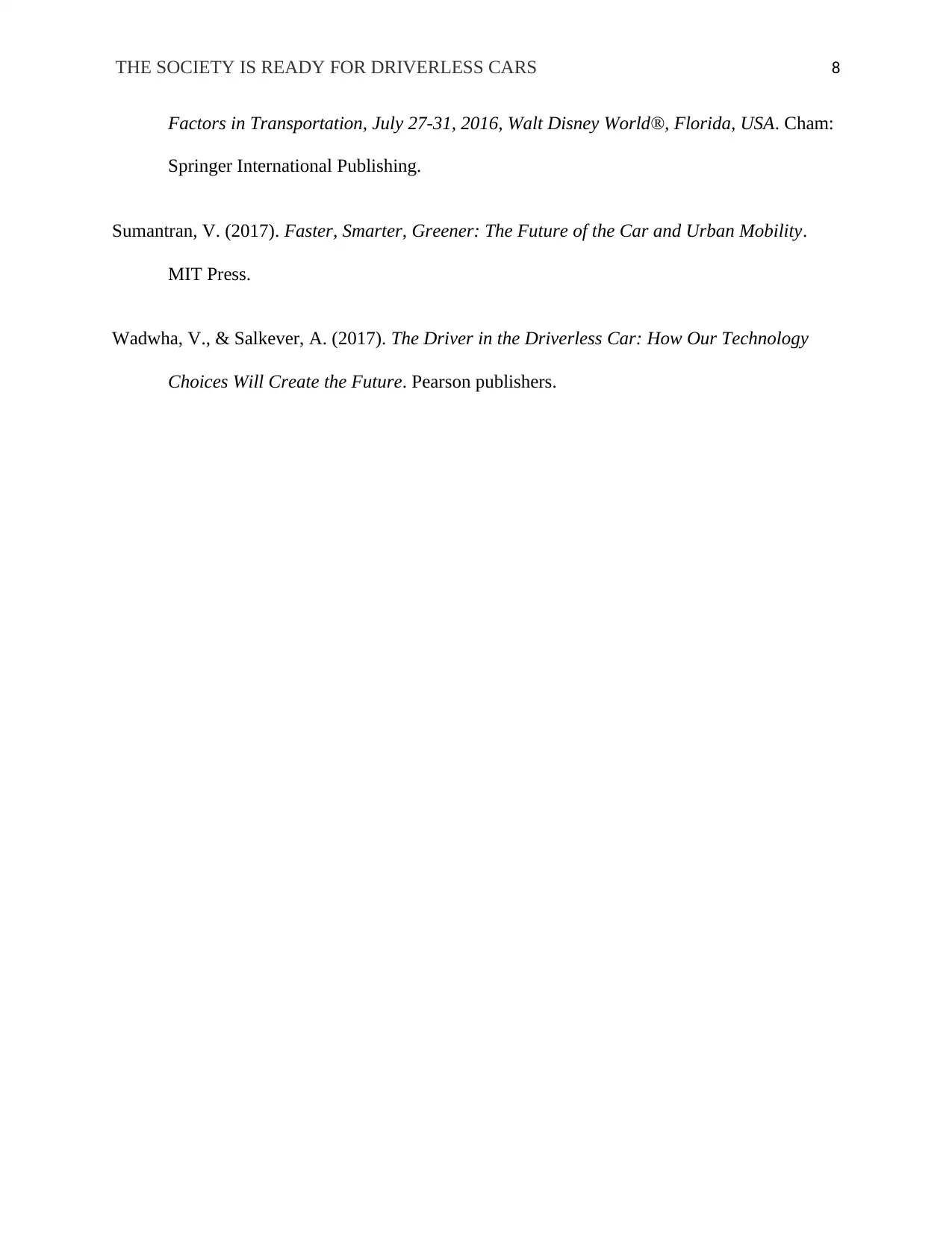
THE SOCIETY IS READY FOR DRIVERLESS CARS 8
Factors in Transportation, July 27-31, 2016, Walt Disney World®, Florida, USA. Cham:
Springer International Publishing.
Sumantran, V. (2017). Faster, Smarter, Greener: The Future of the Car and Urban Mobility.
MIT Press.
Wadwha, V., & Salkever, A. (2017). The Driver in the Driverless Car: How Our Technology
Choices Will Create the Future. Pearson publishers.
Factors in Transportation, July 27-31, 2016, Walt Disney World®, Florida, USA. Cham:
Springer International Publishing.
Sumantran, V. (2017). Faster, Smarter, Greener: The Future of the Car and Urban Mobility.
MIT Press.
Wadwha, V., & Salkever, A. (2017). The Driver in the Driverless Car: How Our Technology
Choices Will Create the Future. Pearson publishers.
1 out of 8
Related Documents
Your All-in-One AI-Powered Toolkit for Academic Success.
+13062052269
info@desklib.com
Available 24*7 on WhatsApp / Email
![[object Object]](/_next/static/media/star-bottom.7253800d.svg)
Unlock your academic potential
© 2024 | Zucol Services PVT LTD | All rights reserved.





